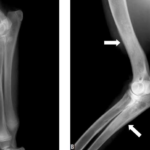Background
Stomach ulceration in humans is a prominent medical condition and there has long been pressure to develop effective and convenient ways to address this problem. Until relatively recently, we relied on simply neutralizing stomach acid by pouring alkaline solutions (i.e., Alka Seltzer, Tums, Rolaids etc.) into the stomach. In fact, ulceration is a complicated process and there are many ways to address it.
Sucralfate was developed as an adjunctive treatment for stomach ulcers in humans. Sucralfate is a sucrose aluminum hydroxide compound that forms a gel-like webbing over ulcerated or eroded tissues, thus serving as a sort of a bandage. It is effective in the upper GI tract: stomach, duodenum (upper small intestine), and esophagus.
Sucralfate not only “bandages” the ulcer but accumulates healing tissue factors in its bandage; it not only protects the ulcer but actively assists in the healing process.
How This Medication Is Used
Sucralfate may be used in any condition associated with stomach ulceration. Common examples include: toxin ingestion, aspirin.
One dose of Sucralfate lasts approximately 6 hours after it is taken orally (by mouth).
Side Effects
Because sucralfate is a locally acting medication and is not absorbed into the body, it has limited side effects potential. Approximately 2% of humans taking sucralfate report constipation as a side effect.
Interactions With Other Drugs
The following medications will be bound by sucralfate and thus will not work as well as normal:
- Tetracycline (an antibiotic)
- Phenytoin (a heart and seizure medication)
- Fluoroquinolone antibiotics (such as enrofloxacin, orbifloxacin, marbofloxacin etc.)
- Digoxin (a heart medication)
- Azithromycin (an antibiotic)
- Doxycycline (an antibiotic)
- Erythromycin (an antibiotic)
- Ketoconazole (an anti-fungal),,
- Theophylline (an airway dilator)
- Thyroxine (thyroid hormone supplement)
This problem is solved by staggering the timing of when you give sucralfate with these other medications by at least 2 hours.
Sucralfate requires stomach acid in order to form its protective gel. If possible, it should be given 30 minutes prior to giving an antacid.
Concerns And Cautions
Sucralfate tablets do not dissolve well intact and should be crushed, mixed in a little water, and given as a slurry.
Despite the sucrose in the molecular formula of this medication, there is no problem administering sucralfate to diabetic patients.
Sucralfate must be given four times daily in order to provide a continuous protective layer on the ulcer. This is an inconvenient schedule but if doses are skipped, the ulcer goes unprotected for that period of time.
Ideally, this medication is given on an empty stomach (at least one hour before feeding or two hours after).


